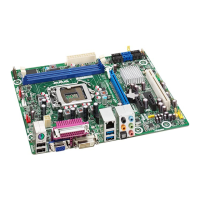
Do you have a question about the Intel DH61BE and is the answer not in the manual?
| Form Factor | Micro ATX |
|---|---|
| Chipset | Intel H61 |
| Socket | LGA 1155 |
| Memory Type | DDR3 |
| Memory Slots | 2 |
| Max Memory | 16 GB |
| PCI Express x16 | 1 |
| PCIe 2.0 x1 Slots | 2 |
| SATA Ports | 4 |
| RAID Support | No |
| Ethernet | 10/100/1000 Mbps |
| Onboard Video | Yes |
| Video Output | DVI, VGA |
Provides a general overview of the board's features and design.
Details supported processors and system memory configurations, including capacities and speeds.
Covers integrated and discrete graphics capabilities and expansion slot types.
Describes USB, SATA, and legacy I/O interfaces like serial and parallel ports.
Details audio codec features and the Gigabit Ethernet controller.
Explains power management features, fan headers, and thermal monitoring.
Details addressable memory, memory map, and address ranges.
Describes back panel and component-side connectors and headers with signal details.
Covers the BIOS configuration jumper block and the Intel MEBX reset header.
Details form factor, dimensions, power supply requirements, and fan header capabilities.
Discusses thermal considerations, MTBF, and environmental specifications.
Explains the Intel BIOS, its storage, update mechanisms, and setup access.
Explains SMBIOS for managing system information in a network.
Details the functionality of legacy USB support for BIOS access and OS installation.
Describes methods for updating the system BIOS using Intel utilities.
Details media types acceptable for BIOS recovery procedures.
Explains how to configure boot devices and boot modes.
Describes the function of the onboard piezoelectric speaker for audible error codes.
Lists and explains the beep code patterns for diagnostic purposes.
Details the blink code patterns of the front panel power LED for error indication.
Lists common BIOS error messages and their explanations.
Explains POST codes generated to I/O port 80h for diagnostics.
Details safety, EMC, and product ecology standards the board complies with.
Presents the EU declaration of conformity for the product.
Addresses worldwide product ecology concerns, including disposal and recycling.
Lists the Electromagnetic Compatibility (EMC) regulations the board complies with.
Details compliance with ENERGY STAR, e-Standby, and ErP requirements.
Shows and explains the various regulatory compliance marks on the board.
Provides important safety warnings and instructions for battery disposal.
